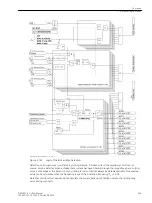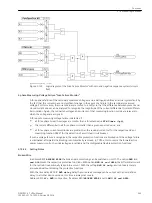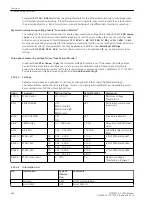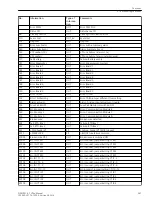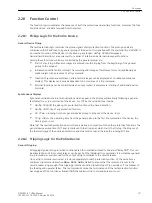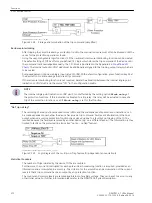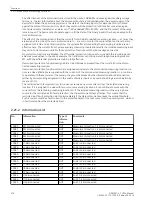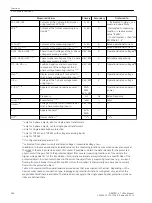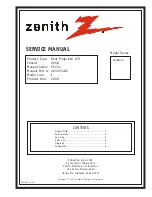
With a PC and the DIGSI protection data processing software it is also possible to retrieve and display the
events and visualised on a monitor and menu-guided dialogue. The data may either be printed, or stored at
another location, and then be evaluated.
Information to a Control Centre
If the device has a serial system interface, stored information may additionally be transferred via this interface
to a central control and storage device. Transmission is possible via different transmission protocols.
You may test whether the indications are transmitted correctly with DIGSI.
Also the information transmitted to the control centre can be influenced during operation or tests. The IEC
60870-5-103 protocol allows to identify all indications and measured values transferred to the central control
system with an added indication “test mode” while the device is being tested on site (test mode). This identifi-
cation prevents the indications from being incorrectly interpreted as resulting from an actual power system
disturbance or event. Alternatively, you may disable the transmission of indications to the system interface
during tests “Transmission Block”).
To influence information at the system interface during test mode (“test mode” and “transmission block”), a
CFC logic is required. Default settings already include this logic (see Appendix).
The SIPROTEC 4 System Description describes in detail how to activate and deactivate test mode and blocked
data transmission.
Classification of Indications
The messages are categorized as follows:
•
Event Log: These are annunciations that may be generated during operation of the device: Information
regarding the status of device functions, measured data, power system data, control command logs, etc.
•
Trip Log: These are fault messages from the last eight network faults that were processed by the device.
•
Messages in switching statistics: These messages count the breaker control commands initiated by the
device, values of accumulated circuit currents and interrupted currents.
•
Resetting/setting of the above messages.
A complete list of all indication and output functions that can be generated by the device with the maximum
functional scope can be found in the Appendix. All functions are associated with an information number.
There it is also indicated to which destination the annunciation can be reported. If functions are not present in
the specific device version, or if they are set to disable, then the associated indications cannot appear.
Operational Annunciations (Buffer: Event Log)
The operational annunciations contain information that the device generates during operation and on opera-
tional conditions.
Up to 200 operational annunciations are stored in chronological order in the device. New annunciations are
added at the end of the list. If the memory has been exceeded, the oldest annunciation is overwritten for each
new message.
Operational annunciations come in automatically and can be read out from the device display or a personal
computer. Faults in the power system are indicated with “Network Fault” and the present fault number. The
fault annunciations (Trip Log) contain details about the history of faults.
Fault Annunciations (Buffer: Trip Log)
Following a system fault, it is possible, for example, to retrieve important information regarding its progress,
such as pickup and trip. The time the initial occurrence of the short circuit fault occurred is accurately provided
via the system clock. The progress of the disturbance is output with a relative time referred to the instant of
fault detection (first pickup of a protection function), so that the duration of a fault until tripping and up to
reset of the trip command can be ascertained. The tripping of the time entry is about 1 ms.
A system fault starts with the recognition of the fault by the fault detection, i.e. first pickup of any protection
function, and ends with the reset of the fault detection, i.e. dropout of the last protection function. Where
fault causes several protective functions to pick up, the fault is considered to include all that occurred between
pickup of the first protection function and dropout of the last protection function.
2.22.1.2
2.22.1.3
Functions
2.22 Auxiliary Functions
SIPROTEC 4, 7UT6x, Manual
277
C53000-G1176-C230-5, Edition 09.2016
Содержание SIPROTEC 4 7UT6 Series
Страница 394: ...394 SIPROTEC 4 7UT6x Manual C53000 G1176 C230 5 Edition 09 2016 ...
Страница 482: ...482 SIPROTEC 4 7UT6x Manual C53000 G1176 C230 5 Edition 09 2016 ...
Страница 504: ...504 SIPROTEC 4 7UT6x Manual C53000 G1176 C230 5 Edition 09 2016 ...
Страница 522: ...522 SIPROTEC 4 7UT6x Manual C53000 G1176 C230 5 Edition 09 2016 ...
Страница 528: ...528 SIPROTEC 4 7UT6x Manual C53000 G1176 C230 5 Edition 09 2016 ...
Страница 538: ...538 SIPROTEC 4 7UT6x Manual C53000 G1176 C230 5 Edition 09 2016 ...
Страница 664: ...664 SIPROTEC 4 7UT6x Manual C53000 G1176 C230 5 Edition 09 2016 ...
Страница 666: ...666 SIPROTEC 4 7UT6x Manual C53000 G1176 C230 5 Edition 09 2016 ...
Страница 683: ...Z Zero sequence currents 109 Index SIPROTEC 4 7UT6x Manual 683 C53000 G1176 C230 5 Edition 09 2016 ...
Страница 684: ...684 SIPROTEC 4 7UT6x Manual C53000 G1176 C230 5 Edition 09 2016 ...

